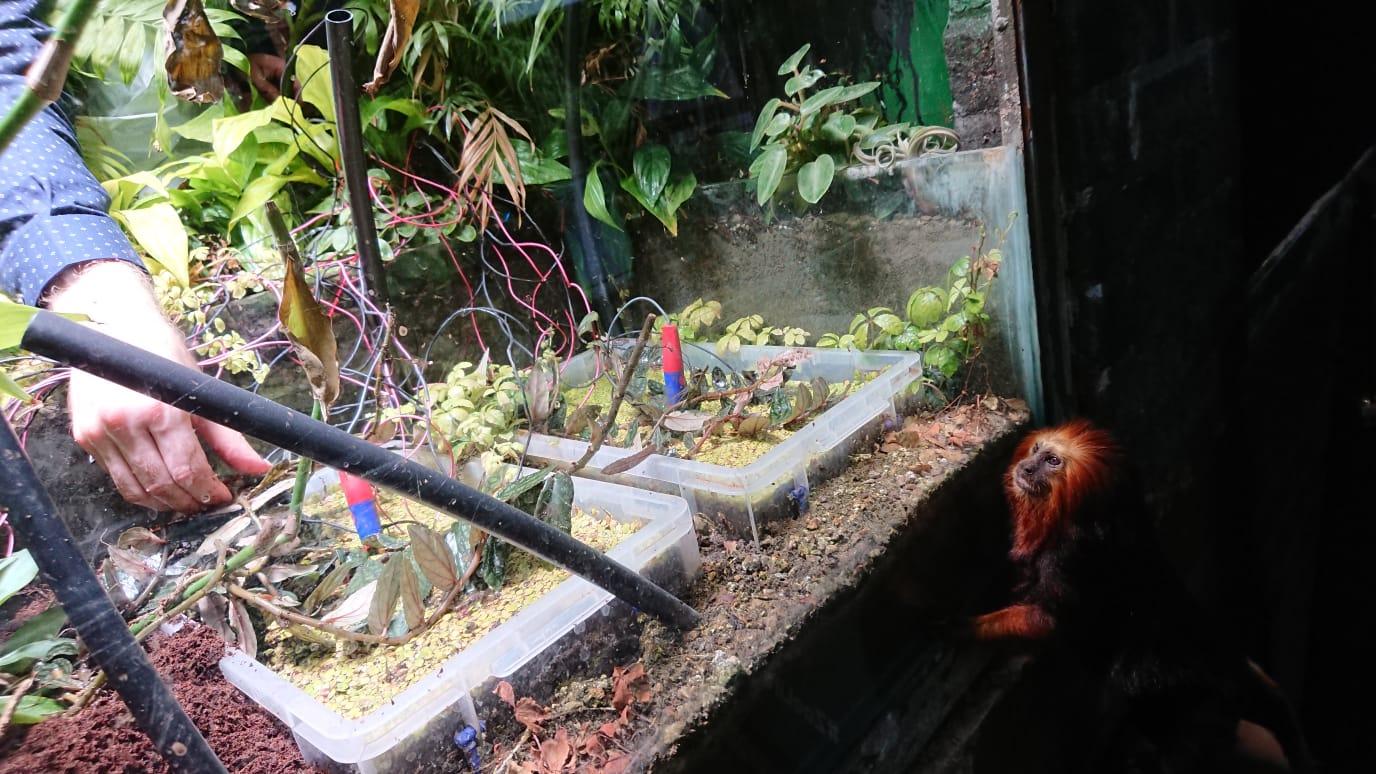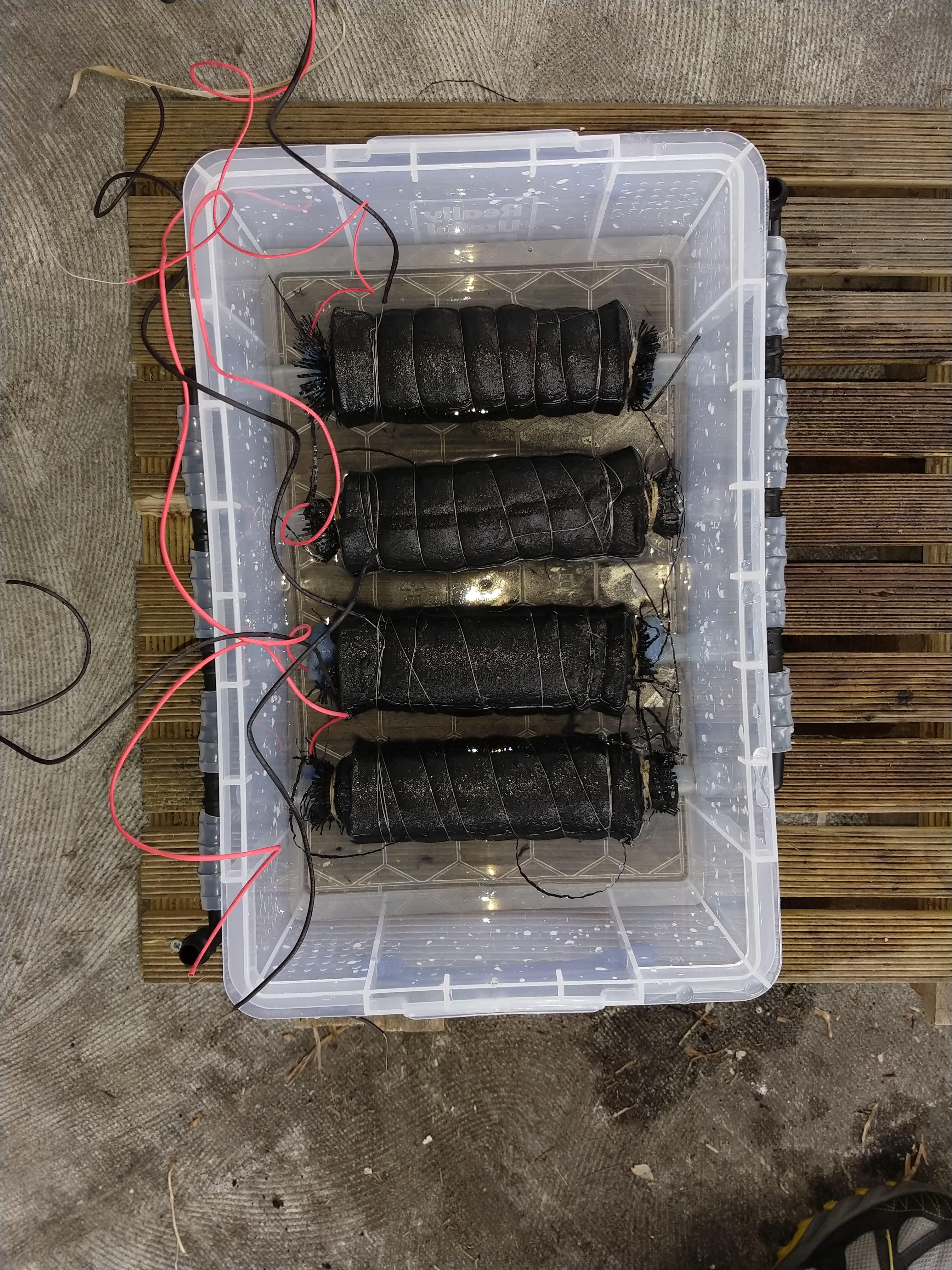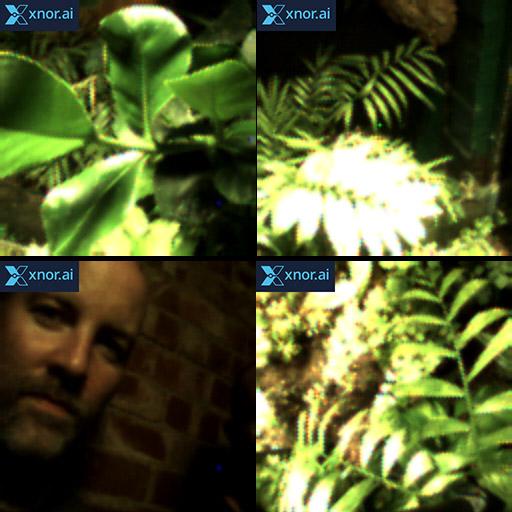If you were to take a trip to ZSL London Zoo this week, you'd be in for a surprise. Over the past few months a team from the Arribada Initiative, Cambridge University (Department of Biochemistry and Botanic Garden) and UCL (Bio-ID) have been working with Plant-E, winners of the Plant-powered Camera Trap Challenge, to install a series of plant microbial fuel cells within the Rainforest Live experience on site.

A visitor to ZSL's Rainforest Live gazes through the window at Plant-E's microbial fuel cells and Xnor.ai's energy harvesting camera.

A curious primate inspects the fuel cells whilst Julian Rodriguez. a Masters student from UCL checks on the status of the system.
The original challenge proposed on WILDLABS the Arribada Initiative and OpenPlant asked engineers, designers and architects to design a bi-electrochemical system that would be capable of delivering et least 5000mC at 5V per day (equal to ~300µW) to power a camera using living plants. Plant-E submitted a design that met this specification and used the prize money to develop 16 cells, split into 4 units, each A4 in size. Working with the ZSL and Botanic Garden (Cambridge) horticultural teams, an exhibit was planted with the cells in the centre. Care was taken to match the soil and plants used in the experiment to that of a similar type found in the wild in rainforests to ensure that the system would work in similar conditions when moved to the wild in the near future. The system was watered and monitored every few days by Julian Rodriguez, a Masters student from UCL, who checked how the electrical output of the system was maturing. It took a few months to reach the current state, with cells capable of generating a countinous and sustanable power output of ~100µW, with a unit (four cells) delivering the required performance.
Next, two ultra low-power energy harvesting cameras were supplied by US-based Xnor.ai, a technology company dedicated to accelerating AI and deep learning in consumer and business devices. As the company that first proved it was possible to run state-of-the-art AI on resource constrained compute platforms, Xnor had pioneered an AI software-hardware integrated approach that could be operated by a ultra low-powering system. Alasdair Davies from the Arribada Initiative reached out to Xnor's engineers to see if they would be interested in supporting the experiment. They kindly provided two of their excellent cameras and were equally fascinated to see if it would be possible to capture photographs using the fuel cells.

The microbial fuel cells designed and developed by Plant-E, winners of the Plant-powered Camera Trap Challenge.
By mid 2019 the experiment was ready to be put to the test - taking the first photographs. Carefully, partners in the project crowded around the camera and connected it to the cells. We then all stared at the camera, waiting patiently in anticipation of a small red & green LED flash. The flash indicates that the supercapacitor has harvested enough power, booting the FPGA (Field Programmable Gate Array) and snapping a photograph within a few milliseconds, saving it to the internal flash memory. We waited, watching a graph plotting the potential of the plant microbial fuel cell changing overtime. Everything looked good, and then, we saw the red & green LED. Then again, and again. At peak output, we could take a photograph every 20 seconds, but this at the expense of operating the plant microbial fuel cell for long periods. We estimate that the system should be capable of taking a photo sustainably and continuously every 8 - 10 minutes with a unit of this size.

Photographs captured by the Xnor.ai energy harvesting camera.
All in all, it took 8 partners and more than 12 months to get everything prepared. Many thanks to OpenPlant for match funding the original competition together with the Arribada Initiative, to Daniel Groen, Andres Riestra and Marjolein Helder from Plant-E for designing and developing the plant microbial fuel cells, to Saman Naderiparizi from Xnor.ai for providing the energy harvesting cameras, to Paolo Bombeli and Chris Howe from Cambridge University's Department of Biochemistry for overseeing and guiding the project to success, to Ángela Cano and Alex Summers for providing the plant material from Cambridge University Botanic Garden’s living plant collection, Brenda Parker, Marcos Cruz and Julian Rodriguez Jirau from Bio-ID (UCL) for helping to monitor the plant microbial fuel cell at the Zoo and also to ZSL for providing a home for the trial in Rainforest Live and to Wildlabs.net for raising awareness of the project. Last but not least, a massive thanks to Alasdair Davies of the Arribada Initiative and ZSL to have initiated and worked to achieve the present exiting results.
As we move forward, there are several other exciting outputs from our first trials;
- We can run AI models on the Xnor.ai cameras. This exciting output from the experiment unlocks access to perpetual AI on the edge, using power derived from the plant microbial fuel cells to continuously run the Xnor.ai cameras, watching for change over time in rainforests and threatened habitats without the need to replace batteries and operating where traditional solar is limited (cloud forests shrowded in mist and in the shade on the forest floor).
- Low-powered environmental sensors could be powered by the fuel cells to measure temperature, humidity, UV and other factors influencing the climate.
- Plant phenology. The cameras could be used to constantly monitor canopy cover, extracting quantitative color information from each picture to assess change at a granular level.
We hope to trial the system in the wild in the near future. For more information please contact Alasdair Davies of the Arribada Initiative if you would to support this project.



Add the first post in this thread.